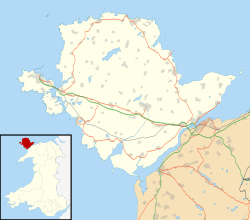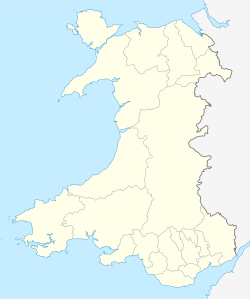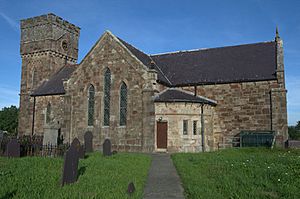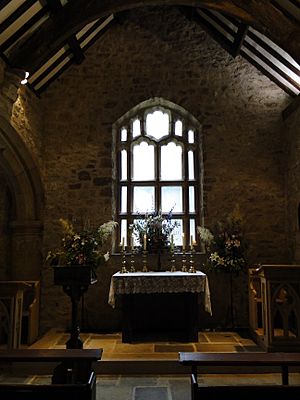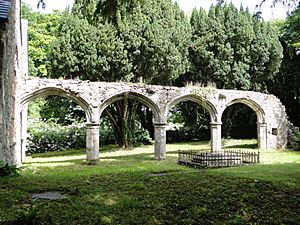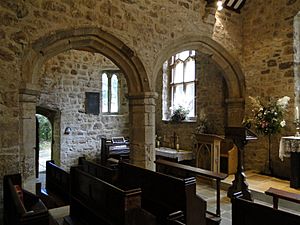Old Church of St Nidan, Llanidan facts for kids
Quick facts for kids Old Church of St Nidan, Llanidan |
|
|---|---|
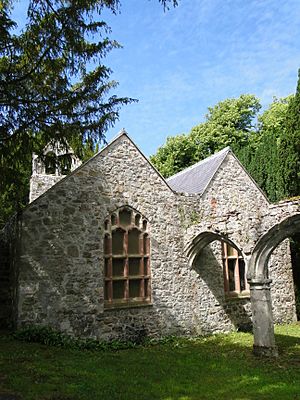
The part of St Nidan's Church that is still standing. You can see the arches that used to be inside.
|
|
| 53°10′40″N 4°15′13″W / 53.17778°N 4.25361°W | |
| OS grid reference | SH 494 669 |
| Location | Llanidan, Anglesey |
| Country | Wales |
| Denomination | Church in Wales |
| History | |
| Status | Church |
| Founded | 616 |
| Founder(s) | St Nidan |
| Dedication | St Nidan |
| Architecture | |
| Functional status | Closed and partly demolished in the 19th century; occasionally open to the public |
| Heritage designation | Grade II* |
| Designated | 30 January 1968 |
| Style | Medieval |
| Specifications | |
| Length | 78 ft (24 m) (pre-demolition) |
| Width | 38 ft (12 m) |
| Materials | Rubble masonry dressed with sandstone |
The Old Church of St Nidan, Llanidan is a medieval church on the island of Anglesey in North Wales. It stands near the Menai Strait, the body of water that separates Anglesey from the mainland. The first church here was built in the 7th century by a holy man named St Nidan.
The building you can see today is much newer. The oldest parts were built in the 14th century. Around the year 1500, the church was made bigger by adding a second main hall, called a nave. The two naves were separated by a row of six stone arches.
In the 1840s, a new church was built nearby. The old church was expensive to repair, so most of it was knocked down. Only the western end and the stone arches in the middle were left standing. At the time, a writer named Harry Longueville Jones was very sad to see the church destroyed. He called it "one of the largest and most important churches in the island of Anglesey."
Today, the ruins of the old church are cared for by the owners of the house next door. It is sometimes opened for visitors. The building is protected as a Grade II* listed building. This means it is considered a very important historic site.
A writer from the 12th century, Gerald of Wales, told a strange story about the church. He said it had a stone shaped like a thigh. No matter how far away someone took the stone, it would always be back at the church the next day. He wrote that a Norman earl even chained it to a heavy rock and threw it into the sea, but the stone returned by morning.
Contents
History of the Church
Building St Nidan's
St Nidan's Church is located in the south of Anglesey, near the village of Brynsiencyn. A church was first started on this spot in the year 616. It was founded by St Nidan, who was a confessor (a type of religious guide) at a monastery in Penmon. The name of the area, Llanidan, comes from the church. In Welsh, llan means "church," and "idan" is part of St Nidan's name.
For many years, the church was owned by a priory (a type of monastery) in Beddgelert. Later, after the dissolution of the monasteries in 1535, King Henry VIII took ownership. The church was eventually passed into the hands of the Boston family, who owned the nearby estate.
The oldest part of the church that still stands is the south nave, which was built in the 14th century. Around 1500, the church was made bigger. A second nave was added on the north side, along with a row of arches to connect the two halls. Making a church bigger this way was not very common in Anglesey.
A New Church is Built
Between 1839 and 1843, a new church was built for St Nidan's parish. The old church needed a lot of repairs. Also, the nearby village of Brynsiencyn was growing, and people wanted a church closer to their homes.
In 1844, most of the old church was demolished. Only the west end and the central arches were saved. For a while, the old building was used as a chapel for funerals. The churchyard was used for burials until 1902. The owners of the nearby house, Plas Llanidan, have since restored the ruins. They use it as a private chapel and sometimes open it for the public to visit.
The decision to knock down the old church was not popular with everyone. The writer Harry Longueville Jones felt the church should have been repaired, not replaced. He said that only the west end was in bad shape, but that was the part they saved. He was upset that the "good portions of the building" were destroyed.
Architecture and Special Features
The Building's Design
St Nidan's has two main halls, or naves, which are separated by a row of stone arches called an arcade. The church also has a small porch on the south side. Before it was partly demolished, the church was 24 meters (78 feet) long. The walls are made of stone and are almost a meter thick.
The roof over the remaining part of the church is made of slate. On top of the roof is a stone bellcote that holds two bells. The south porch has a stone bowl for holy water. An old story says that this bowl never dried up and that its water had healing powers.
There is another entrance on the north side with a 15th-century arch. Above this doorway, two verses from Psalm 84 are written in Welsh. They say, "For one day in thy Courts is better than a thousand. I had rather be a door-keeper in the house of my God than to dwell in the tents of ungodliness."
Two of the six arches of the arcade are now inside the remaining part of the building. The other four arches stand outside in the churchyard. The roof's wooden beams rest on stone supports. Many of the items inside the church today, like the granite altar, are modern and came from other churches.
The Magical Stone and Saint's Bones
In the 12th century, the writer Gerald of Wales wrote about a special stone at the church. It was shaped like a human thigh and was called the "homing stone." He said that if anyone tried to move it, the stone would magically return to the church by itself.
A local historian named Henry Rowlands, who was the vicar of the church in the 1690s, wrote that the stone was eventually stolen from the churchyard wall.
While Rowlands was the vicar, a small stone chest was found buried under the altar. Inside were pieces of bone. Rowlands believed they were the relics (remains) of a saint. This sandstone chest is now kept in the new church. Many people believe it holds the remains of St Nidan himself. The church's 13th-century font, which is used for baptisms, was also moved to the new church.
Why St Nidan's is Important Today
The Old Church of St Nidan is a Grade II* listed building. This is a special status given to "particularly important buildings of more than special interest." It is protected because it is a good example of a simple medieval church that was improved in the 15th century. Even though it is partly a ruin, it is an important example of a church with two naves.
Before it was knocked down, visitors thought the church was very impressive. In 1802, one visitor said it seemed "superior to the generality of Welsh buildings of the kind." Harry Longueville Jones called it "one of the largest and most important" churches in Anglesey because of its history and architecture.
Even as a ruin, the church is admired. One writer described the stone arcade as rising "from the graveyard like an abstract sculpture." Another said that visiting the quiet churchyard is a "rewarding" experience. A 2005 guide to Wales called the "romantic yew-encircled ruin" of St Nidan's a place that "should not be missed."
Images for kids
See also
 In Spanish: Antigua iglesia de San Nidan para niños
In Spanish: Antigua iglesia de San Nidan para niños


